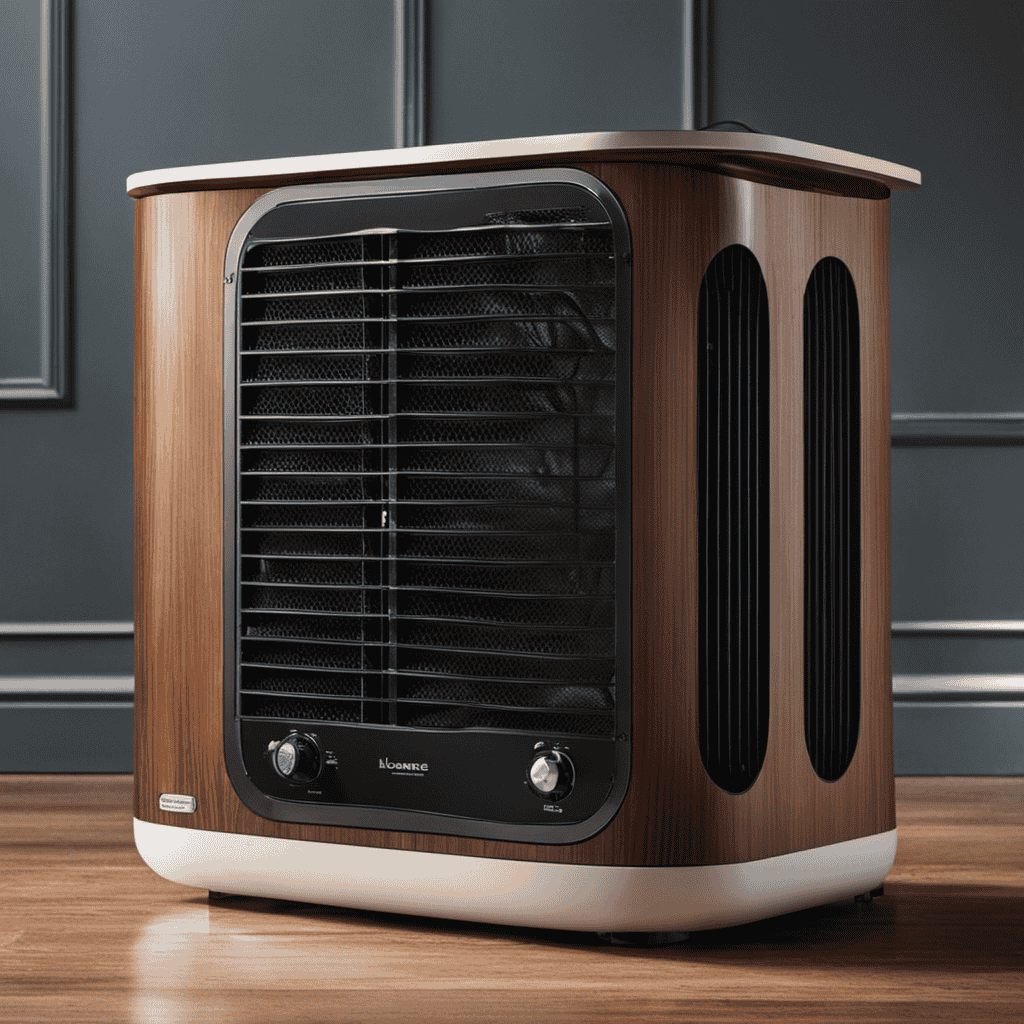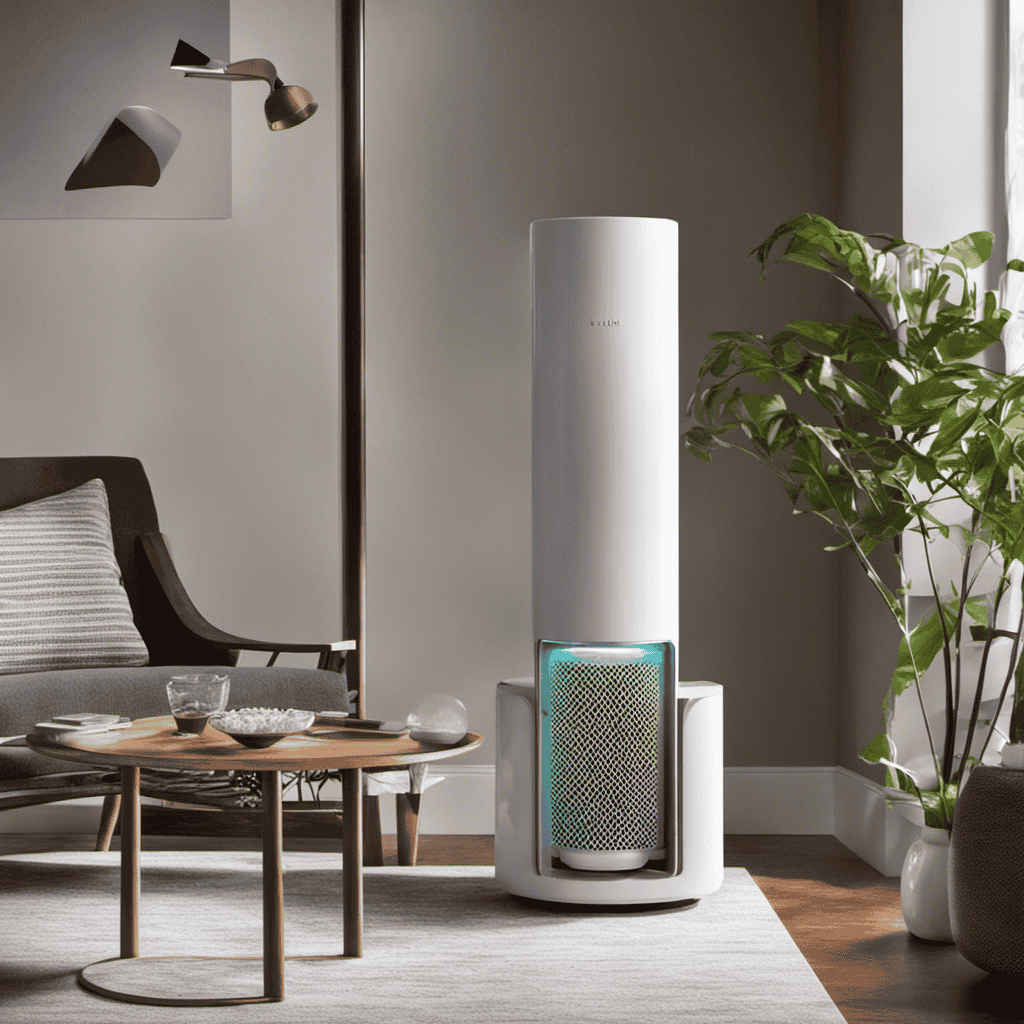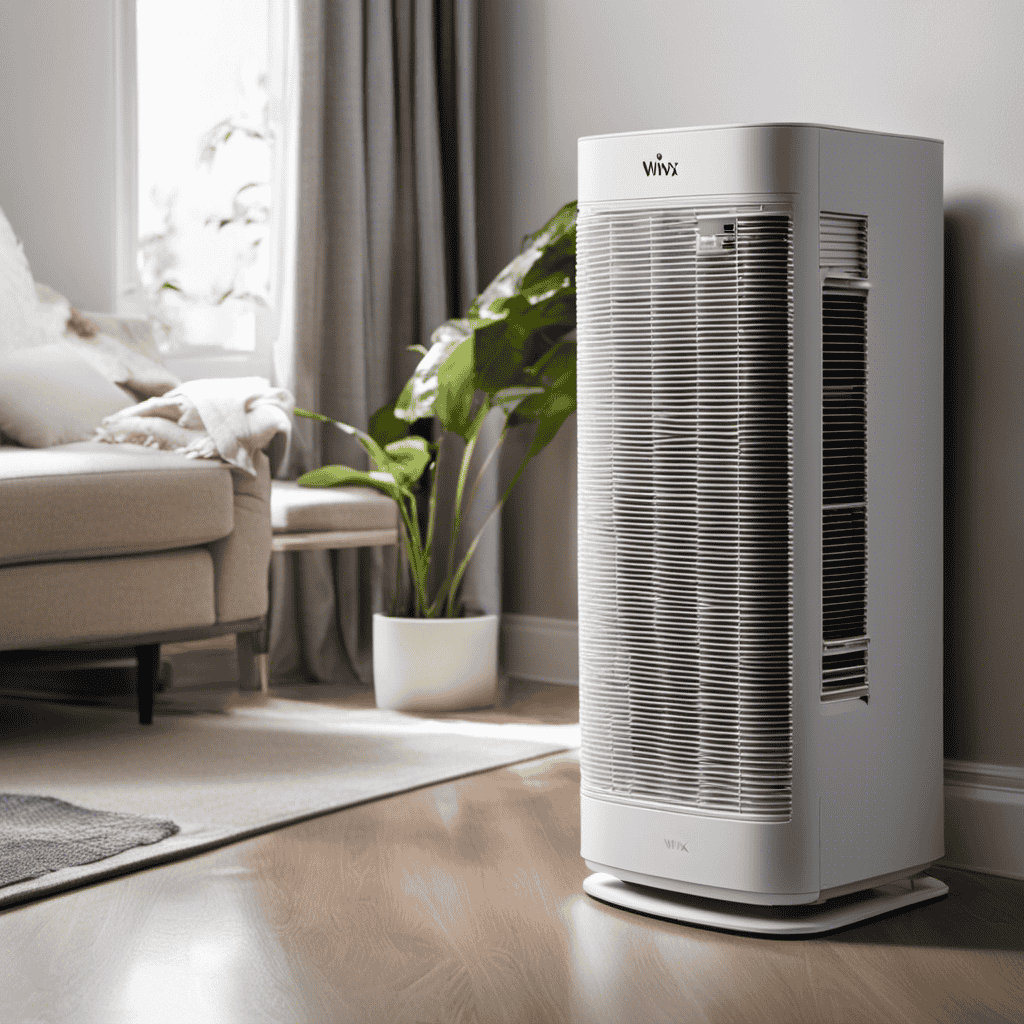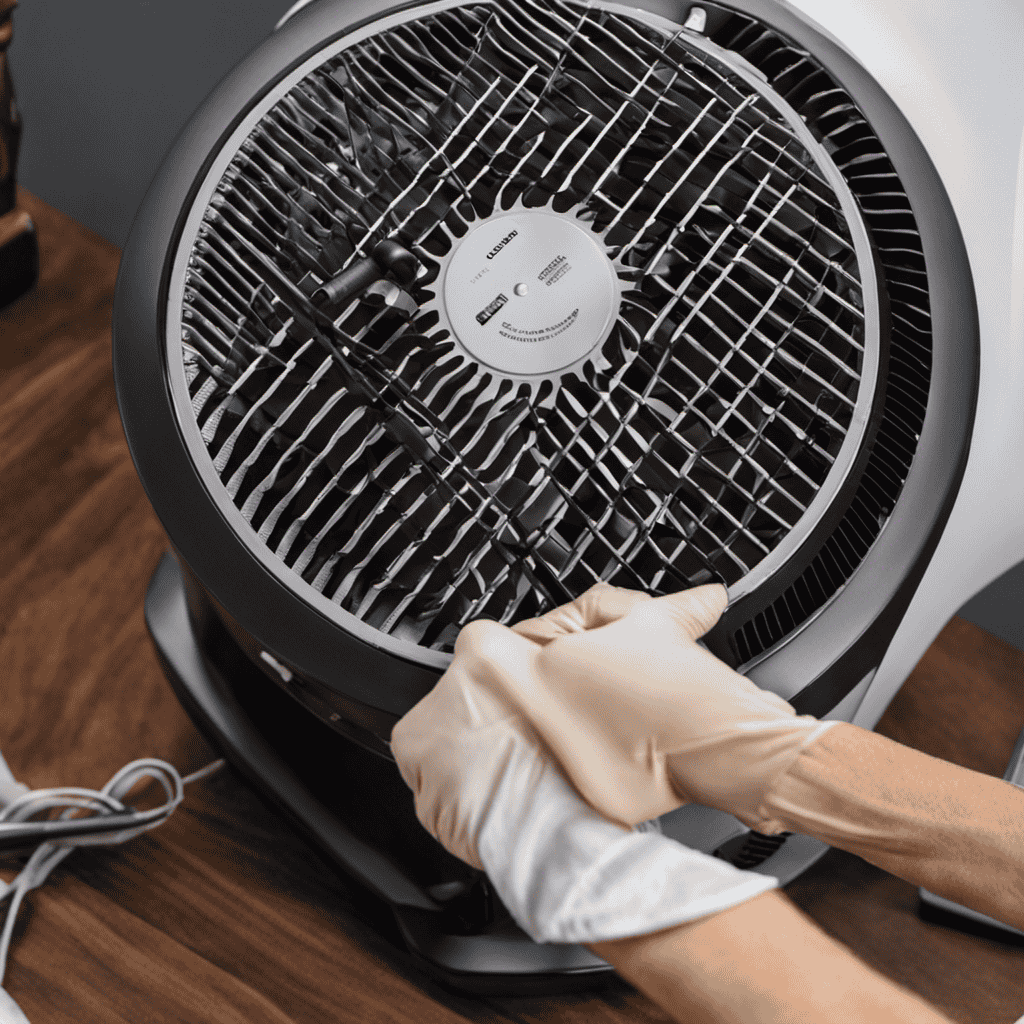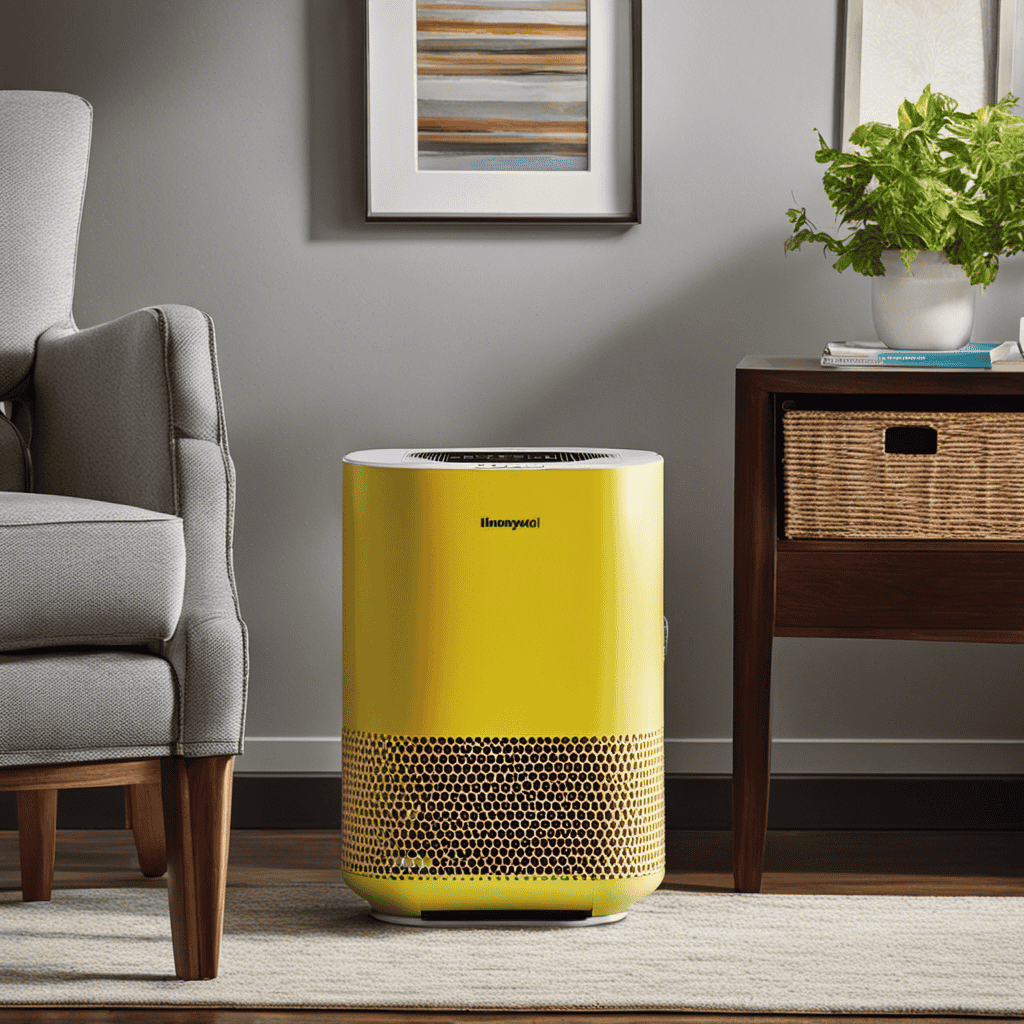Hello! I’ve come to offer my insights on effectively cleaning your Holmes air purifier’s fan. Believe me, routinely cleaning the fan is essential for ensuring peak performance and maintaining the cleanliness and freshness of your home’s air.
In this article, I’ll guide you through the step-by-step process of disassembling, cleaning, and reassembling the fan, ensuring it functions like new.
So, let’s get started and make sure your air purifier is working at its best!
Key Takeaways
- Regular fan cleaning is important for maintaining proper airflow and improving fan performance.
- Cleaning the fan helps prevent dust buildup and enhances indoor air quality.
- Proper cleaning techniques for the fan blades include using a soft-bristle brush, wiping with a damp cloth, and using compressed air or vacuum for hard-to-reach areas.
- Cleaning the fan motor and internal components involves removing fan filters, washing them with warm soapy water, and using a soft brush or vacuum to remove dust from fan grills.
Importance of Regular Fan Cleaning
Regularly cleaning the fan is important because it helps to maintain proper airflow and prevent dust buildup. Not only does this improve the performance of the fan, but it also enhances the quality of the air we breathe.
When dust and debris accumulate on the fan blades, they can be circulated back into the room, leading to poor indoor air quality. By using the best cleaning products, such as a mild detergent or vinegar solution, you can effectively remove dirt and grime from the fan.
Clean air is essential for our health, as it reduces the risk of allergies, respiratory issues, and other health concerns. Taking the time to clean your fan regularly ensures that you and your family can enjoy the benefits of clean air.
Now, let’s move on to the tools and materials needed for fan cleaning.
Tools and Materials Needed for Fan Cleaning
To clean your fan, you’ll need a few tools and materials. First, gather a screwdriver, a soft cloth or sponge, and a vacuum cleaner with a brush attachment. These tools will help you remove any dust or debris that has accumulated on the fan blades and in the motor housing.
Additionally, you’ll need some cleaning materials to effectively clean the fan. Prepare a mixture of warm water and mild dish soap in a bucket or basin. This solution will help break down any dirt or grime on the fan surfaces. You may also want to have some rubbing alcohol or vinegar on hand to disinfect the fan and remove any stubborn stains.
With these tools and cleaning materials, you’ll be able to clean your fan thoroughly and ensure it continues to operate efficiently.
Preparing the Air Purifier for Fan Cleaning
Before beginning the cleaning process, make sure you unplug the air purifier from the power source. This is an important pre-cleaning precaution to ensure your safety and avoid any electrical accidents. Once you have unplugged the device, you can proceed with cleaning the fan.
Here are some common fan cleaning mistakes to avoid:
-
Using excessive force: When cleaning the fan, it’s important to be gentle and avoid applying too much pressure. This can damage the fan blades or the motor.
-
Neglecting to clean the surrounding area: Before cleaning the fan, make sure to clear the area around it. Dust and dirt can accumulate on nearby surfaces, so it’s important to clean those as well.
-
Not following the manufacturer’s instructions: Each air purifier may have specific instructions for cleaning the fan. Be sure to read and follow these instructions to avoid any damage or voiding the warranty.
Step-by-Step Guide to Disassembling the Fan
When disassembling the fan, make sure you start by removing the front grill to access the blades for cleaning. This is an essential step in the disassembling process of the Holmes air purifier. Cleaning the fan blades is crucial for maintaining the efficiency and performance of the air purifier.
To help you understand the disassembling process better, here is a step-by-step guide:
- Start by unplugging the air purifier from the power source for safety.
- Locate the screws holding the front grill in place and use a screwdriver to remove them.
- Once the screws are removed, carefully lift and remove the front grill.
- Now, you will have access to the fan blades. Use a soft brush or a damp cloth to gently remove dust and debris from the blades.
- After cleaning the blades, reassemble the front grill by securing it back in place with the screws.
Proper Cleaning Techniques for the Fan Blades
Make sure you gently brush or wipe the blades to remove any dust or debris that may have accumulated. Proper cleaning techniques for fan blade maintenance are crucial in ensuring optimal performance and longevity of your Holmes air purifier.
Here are three effective methods to clean your fan blades:
-
Use a soft-bristle brush: Start by unplugging the air purifier. Then, gently brush the blades using a soft-bristle brush to loosen any dust or dirt. Be careful not to apply too much pressure to avoid damaging the blades.
-
Wipe with a damp cloth: Dampen a clean cloth with water or a mild cleaning solution. Gently wipe the blades to remove any remaining dirt or grime. Make sure to dry the blades thoroughly before reassembling the fan.
-
Compressed air or vacuum: If your air purifier has hard-to-reach areas or stubborn dirt, you can use compressed air or a vacuum with a brush attachment. This will help remove any trapped debris and ensure a thorough cleaning.
Cleaning the Fan Motor and Internal Components
To ensure optimal performance and longevity, it’s important to regularly clean the motor and internal components of your air purifier.
Cleaning the fan filters and fan grills is crucial for maintaining the efficiency of your Holmes air purifier.
Start by unplugging the air purifier and removing the fan filters. Gently wash the filters with warm soapy water and allow them to completely dry before reinstalling them.
Next, use a soft brush or vacuum cleaner to remove any dust or debris from the fan grills. Pay extra attention to the areas around the motor where dust tends to accumulate.
For the internal components, use a soft cloth or brush to wipe away any dirt or dust. Avoid using any liquids on the motor or electronics.
Regularly cleaning these parts will ensure that your air purifier continues to function effectively and provide clean air for your home.
Reassembling the Fan and Testing for Proper Functionality
When it comes to reassembling the fan, it’s important to follow a specific process to ensure everything is put back together correctly.
I’ll walk you through the step-by-step fan reassembly process, including how to properly align the motor and blades.
Once the fan is reassembled, we’ll discuss different methods for testing its functionality to ensure it’s working properly.
And if you encounter any issues along the way, I’ll provide troubleshooting tips to help you identify and fix common fan problems.
Fan Reassembly Process
After cleaning the fan, it’s time to reassemble it in the Holmes air purifier. Here are some troubleshooting tips to ensure a smooth fan reassembly process:
-
Begin by aligning the fan blades correctly. Look for any arrows or markings that indicate the correct orientation.
-
Carefully place the fan back into its housing, making sure it fits securely and snugly.
-
Use the screws or clips provided to reattach the fan housing to the purifier unit.
By following these steps, you can avoid any potential issues and ensure that the fan is properly reassembled. Once the fan is reassembled, it’s time to move on to testing the functionality of the Holmes air purifier.
Now that the fan is securely reassembled, let’s move on to the next step: functionality testing methods.
Functionality Testing Methods
Now that we have reassembled the fan, it is important to test its performance to ensure it is functioning properly. Testing the fan performance will give us confidence that our cleaning efforts have been successful. There are a few techniques that can be used to test the fan’s functionality.
One method is to visually inspect the fan blades while the device is turned on. Look for smooth and consistent rotation, without any wobbling or unusual noise. Another technique is to use a piece of tissue paper or a smoke source near the fan to check if it is producing a strong and steady airflow. Additionally, you can use an anemometer to measure the air velocity produced by the fan. Compare the results to the manufacturer’s specifications to determine if the fan is operating at the expected level.
To help you better understand the testing methods, here is a table that summarizes the different techniques:
| Testing Technique | Description |
|---|---|
| Visual Inspection | Check for smooth rotation, no wobbling, and no unusual noise. |
| Airflow Test | Use tissue paper or smoke source to check for strong and steady airflow. |
| Anemometer Measurement | Measure the air velocity produced by the fan and compare it to the manufacturer’s specifications. |
Troubleshooting Fan Issues
If the fan is experiencing issues, troubleshooting can help identify and resolve the problem. Here are three common fan issues and their possible solutions:
-
Fan Noise: If your fan is making excessive noise, it could be due to a loose or damaged fan blade. First, check if any debris is stuck in the fan. If not, tighten any loose screws on the fan blade or motor housing. If the noise persists, it may be necessary to replace the fan blade or motor.
-
Fan Speed Control: If your fan is not operating at the desired speed, check if the speed control settings are correctly adjusted. Ensure that the fan is plugged into a power source and that the speed control dial or buttons are set to the desired level. If the issue persists, there may be a problem with the fan’s internal wiring or motor, and professional assistance may be required.
-
Power Issues: If your fan is not turning on at all, first check if it is properly plugged in and if the power outlet is functioning. If everything is connected correctly, check the fan’s power switch or control panel for any damage or debris. If necessary, replace the switch or contact customer support for further assistance.
Remember to always follow safety guidelines and consult the user manual for specific troubleshooting instructions for your particular fan model.
Maintenance Tips to Keep Your Fan Clean and Efficient
When it comes to keeping your fan clean and efficient, there are a few key points to consider.
First, it’s important to know the recommended cleaning frequency for your specific fan model. This can vary depending on factors such as usage frequency and environment.
Secondly, using the best cleaning methods is crucial to ensure that you are effectively removing dust and debris without causing any damage to the fan.
Lastly, regular maintenance is of utmost importance to prevent buildup and maintain optimal performance.
Cleaning Frequency Recommendations
Regular maintenance is crucial for keeping your Holmes air purifier’s fan clean and functioning properly. Cleaning the fan regularly not only ensures optimal performance but also provides several benefits.
Here are some cleaning frequency recommendations and the benefits of regular fan cleaning:
-
Monthly cleaning: It is recommended to clean the fan of your Holmes air purifier at least once a month. This helps remove dust, pet dander, and other airborne particles that accumulate on the fan blades, allowing it to circulate clean air effectively.
-
Improved air quality: Regular fan cleaning prevents the buildup of dirt and debris, maintaining the air purifier’s efficiency in filtering out pollutants. This leads to improved indoor air quality and reduces the risk of allergies and respiratory issues.
-
Prolonged lifespan: Cleaning the fan regularly removes dust and debris that can cause excessive strain on the motor. By reducing the workload, regular cleaning helps extend the lifespan of your Holmes air purifier.
Best Cleaning Methods
To effectively maintain your Holmes air purifier, try using a damp cloth or a soft brush for cleaning. These methods are gentle enough to avoid damaging the fan while still effectively removing dust and debris. However, it is important to use the best cleaning supplies to ensure a thorough and efficient cleaning process. I recommend using a mild detergent or a vinegar and water solution for tougher stains or buildup. Additionally, it is crucial to address common fan problems that may arise during the cleaning process. These can include issues such as the fan not spinning or making unusual noises. By regularly cleaning and maintaining your Holmes air purifier, you can ensure optimal performance and longevity.
| Cleaning Supplies | Common Fan Problems |
|---|---|
| Soft brush | Fan not spinning |
| Damp cloth | Unusual noises |
| Mild detergent | Poor airflow |
| Vinegar and water solution | Oscillation issues |
Importance of Regular Maintenance
Make sure you consistently maintain your air purifier to ensure optimum performance and longevity. Regular maintenance not only keeps your air purifier running efficiently but also provides several benefits for your health and well-being.
Here are three maintenance benefits and cleaning techniques to keep in mind:
-
Improved Air Quality: Regularly cleaning and replacing filters removes pollutants, allergens, and odors from the air, creating a cleaner and healthier environment for you and your family.
-
Increased Lifespan: By regularly cleaning the fan, motor, and other components, you can prevent dust and debris buildup, which can lead to decreased performance and potential damage over time. This maintenance routine helps extend the lifespan of your air purifier.
-
Cost Savings: A well-maintained air purifier operates more efficiently, consuming less energy and reducing electricity bills. Additionally, proper maintenance can prevent major repairs or the need for a replacement unit, saving you money in the long run.
Remember to consult your air purifier’s manual for specific cleaning instructions and recommended maintenance schedules to maximize the benefits and longevity of your device.
Frequently Asked Questions
How Often Should I Clean My Holmes Air Purifier Fan?
I clean my Holmes air purifier fan every 3-6 months. Regular cleaning ensures optimal performance and extends the lifespan of the fan. It also helps maintain the air purifier’s efficiency in filtering out pollutants, providing clean and fresh air at home.
Can I Use Any Cleaning Solution to Clean the Fan Blades?
Yes, you can use a cleaning solution to clean the fan blades of your Holmes Air Purifier. However, it is important to use a mild, non-abrasive solution to avoid damaging the blades. Alternatively, you can also use a damp cloth to wipe the blades clean.
Is It Safe to Clean the Fan Motor and Internal Components With Water?
No, it is not safe to clean the fan motor and internal components with water. Water can damage electrical components and cause malfunction. It is best to use recommended cleaning methods and alternative cleaning solutions.
What Should I Do if I Encounter Any Difficulties While Reassembling the Fan?
If I encounter any difficulties while reassembling the fan, I can troubleshoot the issue by referring to the user manual or seeking online tutorials. These resources provide helpful tips and step-by-step instructions to ensure successful reassembly.
Are There Any Specific Maintenance Tips to Prevent Dust Buildup on the Fan Blades?
To prevent dust buildup on fan blades, regular cleaning is essential. Dusting the blades with a soft cloth or using a vacuum attachment can help remove accumulated dust. Taking these maintenance steps will ensure optimal performance.
Conclusion
In conclusion, keeping your Holmes air purifier fan clean is crucial for maintaining its efficiency and performance.
Just like a breath of fresh air symbolizes renewal and vitality, a clean fan represents a refreshed and purified environment.
By following the step-by-step guide and using the proper cleaning techniques, you can ensure that your fan remains free from dust and debris.
Remember to regularly maintain your fan to enjoy clean and fresh air in your home or office.
